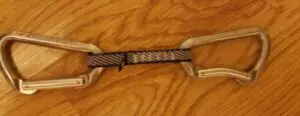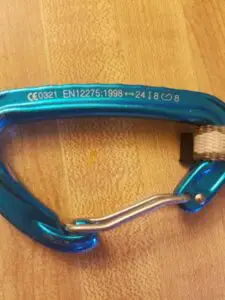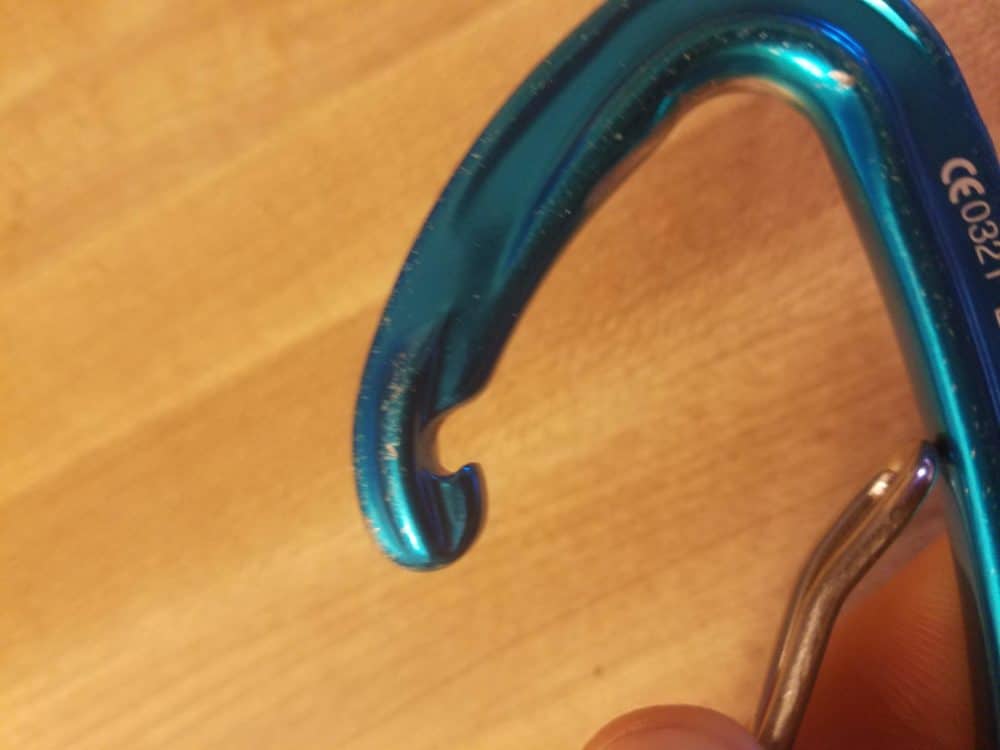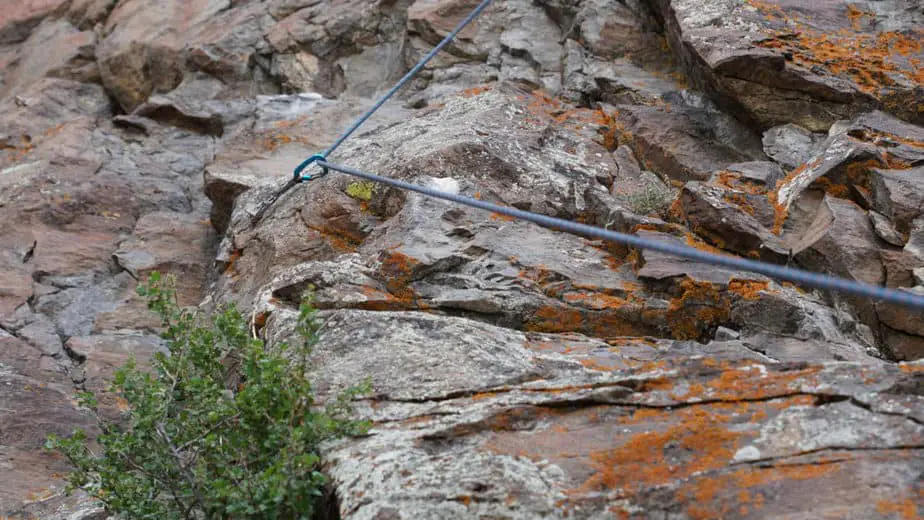To non-climbers, climbing gear is incredibly suspect. If you ask a climber though, we usually offer some explanation about how a carabiner can hold up a truck, and that they never break when used correctly, and we always use them correctly (because we’re climbers). Quickdraws are comprised of two metal carabiners with a sling (dogbone) connecting them. We tend to trust metal hardware a lot more than gear made of nylon and other rope materials. It’s important to understand how the sling and non-locking carabiners affect the weight and strength factors of quickdraws.
A quickdraw, when loaded properly, is rated to hold up to 20N (about 4500 lbs or 2000kg), the strength rating of the carabiner’s major axis. The huge caveat here though is that climbing gear is rated for FORCE, not for WEIGHT.
While you could hang a car from a quickdraw and it would hold the weight, it couldn’t do so if you dropped or bounced a car on the quickdraw. Dynamic forces add a significant amount of force to the system, which increases the safety requirements. The other concern is the wear and tear on the quickdraw over time.

How Strong are Quickdraws?
Just because a carabiner in a quickdraw can hold the weight of 25 people doesn’t mean you should try it. The physics equation of Force=mass*gravity yields the actual strength requirements for a quickdraw catching a lead fall. The strength required to catch a falling climber is around ten times the weight of the climber due to the acceleration due to gravity of 9.8m/s^2. Still, even with the gravity factor, climbing gear is rated well above what climbers really need.
A quickdraw is as strong as its weakest link- which is actually the carabiners in a brand new quickdraw. The CE / UIAA requirements for the dogbone (sling between the two carabiners) are 22kN when new, and the requirements for a carabiner (major axis load) are 20kN.
It’s important to realize that the ratings shown on climbing gear are the strength factors the gear has when brand new. Climbing gear, slings and ropes especially, wears out over time. The carabiners are actually the ‘weak link’ in the quickdraw initially, but the slings wear out more quickly over time. See below for information on wear and tear, and how often quickdraws should be replaced.
Quickdraw Features
Take a look at a quickdraw and you’ll notice that each gate (the part that opens and closes) is shaped differently. Usually, one gate is concave, and one is straight. The straight gate is designed to go into the bolt on the cliff, whereas the concave gate is designed for the rope. The reason for this is to be able to more easily snag the rope when you’re clinging to the rock for dear life.
Another feature that you’ll see on quickdraw gates is solid gates versus wire gates. If your quickdraw has both, the solid gate goes against the bolt and the wire gate is for the rope. At first glance it would appear that a wiregate is much more flimsy and potentially more dangerous than a solid gate biner, but they’re actually about the same.

Black Diamond compared the minor axis breaking points (see minor axis info below) between the two types of carabiners and found that they were equivalent, and sometimes wire gate carabiners even held out longer because the gate bent instead of broke flat out. You can read the results of their study in this article .
.
They make different lengths of dogbones for quickdraws. They range from about 12cm to 60cm. For most sport climbing, you just want the short bones, but if you do any multi-pitch or trad climbing you may want the longer ‘alpine draws.’ The slings also come in different widths and materials, which usually have differing strengths, as well as weights.
Carabiner Strength Requirements
Carabiners have 3 strength requirements stamped on them. They usually have some sort of a symbol designating which number (in kiloNewtons) corresponds to which rating. The 3 strength ratings are for major axis strength, minor axis strength, and open gate strength. As you can see from the image below, this quickdraw carabiner made by Cypher has a major axis strength of 24kN (horizontal arrows), and minor axis strength (vertical arrows) and open gate strength (open carabiner symbol) factors of 8kN each. Is that enough?
has a major axis strength of 24kN (horizontal arrows), and minor axis strength (vertical arrows) and open gate strength (open carabiner symbol) factors of 8kN each. Is that enough?

The maximum force of a lead fall on a carabiner’s main axis is up to about 6kN, according to a study done by Petzl . The UIAA has stated that the maximum force a falling lead climber generates is around 5kN. Regardless, this strength is plenty compared to the ratings of 20kN+ on carabiners loaded correctly.
. The UIAA has stated that the maximum force a falling lead climber generates is around 5kN. Regardless, this strength is plenty compared to the ratings of 20kN+ on carabiners loaded correctly.
The carabiner above has sufficient strength to handle just about any fall then, according to Petzl, but some carabiners only have a minor axis strength of 6kN. Cross loading does happen occasionally and can lead to carabiner failure, so it’s important to know how to identify it and avoid it when possible.
Cross-Loading a Carabiner
Carabiners are designed to hold weight or force across the major axis. They come in various shapes that are all designed so that forces apply to the major axis instead of the minor axis. Occasionally, especially when belaying, the carabiner shifts horizontally and the opposing forces equalize keeping the carabiner from shifting towards the major axis. This is called cross-loading, and can be extremely dangerous.
Other than the nose, the gate is the weakest part of the carabiner. This is especially true of non-locking biners. The force applied to the carabiner will break the gate open before it will break through the solid aluminum or steel.
Several companies make a locking carabiner with a different shape or an interior gate to lower the risk of cross-loading, such as this one from Black Diamond . The interior gate makes it so the carabiner will most likely take the force of a fall or whatever on the major axis instead of on the gate.
. The interior gate makes it so the carabiner will most likely take the force of a fall or whatever on the major axis instead of on the gate.
These have been around for a while though now, and haven’t really caught on. The risk of cross-loading is minimal, though it does happen, so most climbers aren’t willing to pay more money for specialized carabiners.
Nose-Loading a Carabiner
Nose loading should never happen when climbing, but occasionally it does. While carabiners are rated to handle cross-loading, they are not rated for nose loading. Black Diamond did a study on the weight that the nose of a carabiner can hold, and found that it’s usually around 2kN (550lbs of force). This much force is easily generated by a short fall, so this is potentially catastrophic if it occurs.
on the weight that the nose of a carabiner can hold, and found that it’s usually around 2kN (550lbs of force). This much force is easily generated by a short fall, so this is potentially catastrophic if it occurs.

The issue of nose loading is one of the reasons we use locking carabiners on harnesses- there’s a lot more potential for shifting and opposing forces. The most important thing when lead climbing or setting up an anchor is to make sure the quickdraw clips all of the way through the bolt and doesn’t just sit on the nose. It would be beneficial to get in the habit of checking this as you confirm that the quickdraw gates are facing away from the wall so you don’t accidentally z-clip.
In order to eliminate or at least minimize the risk of nose loading, you can look for carabiners with a special “Keylock” feature. This eliminates the hook on the nose, but maintains the functionality and strength. One example is Black Diamond’s Posiwire quickdraw.
Quickdraw Sling Strength Requirements
Quickdraws come with slings that are folded over and sewn together in the middle so that there are loops on either end for the carabiners. Slings are usually sewn in a bar pattern for strength and so that the carabiners don’t slide as much. They often also include a rubber piece underneath at least one loop that secures the carabiner to keep it from moving around when you’re trying to clip.
Dogbones have to be rated for at least 22kN in order to get the CE certification. They are usually a little bit stronger than carabiners, but that’s due to the shorter lifespan. They can wear out fairly quickly due to UV rays and abrasion, if they’re left out in the sun. A really worn out sling can decrease to around 3-5kN of strength, which is likely to fail.
The slings can be made of nylon or polyester, or a type of polyethylene.
How long do Quickdraws last?
Quickdraws can usually last 2-3 years with consistent use, as long as they are largely kept out of the elements. With a strength rating of 22kN for the sling and 20kN for the carabiners, in theory the carabiner would break before the sling. Abrasion and UV rays inflict a lot more damage on slings though, which is why they generally need to be replaced more often than the carabiners.
Dogbones on quickdraws are made from a few different materials, depending on the brand. Most of them are made from some variation of nylon webbing, whether Dynex, Spectra, or Dyneema. Slings wear through abrasion and UV rays. Black Diamond did a semi-scientific study on how webbing and slings wear out, which you can find in this article .
.
Webbing rapidly deteriorates within about 10 weeks out in the sun. For quickdraws that don’t stay fixed on a cliff, they last a pretty long time- 2 or 3 years with consistent use. You should treat your draws like you treat your rope. Inspect them for abrasion damage and any signs of UV wear, and retire them as often as needed. Additionally, you should replace at least the dogbone if you take a lead fall onto a quickdraw.
The carabiners themselves actually can last a lot longer. The main thing you’re looking for is grooves in the metal (especially if they sharpen any part of it), rust, or signs that the gate may be slowing down and may not close automatically. Gear failure is mostly a myth. Carabiners usually only break if they are cross-loaded or loaded on the nose, as described above.
My Recommendation
You can take a look at the quickdraws, and other climbing and canyoneering hardware that we use and recommend on this page .
.


